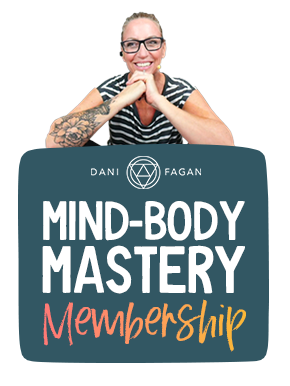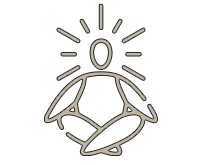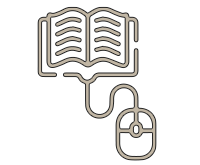1
Learn about the mind-body connection
Understand the mind-body connection and why chronic symptoms occur
Knowledge is the foundation of all mind-body healing and is achieved from a deep understanding of the relationship between the brain and the body. Recognising that we are emotional beings and understanding that our emotional world and the state of our nervous system can create distressing physical symptoms is the basis of all mind-body medicine.
Keep an open mind
All I ask is that you go into this with an open heart and open mind and be willing to hear about a different way of healing than you might be used to. The mind-body approach is quite different from the typical medical/pharmaceutical model that focuses on symptomatic relief with medicines and surgeries, rather than treating the root causes of our discomfort.
You might find it surprising that I'm not going to recommend specific treatments or physical exercises to soothe your suffering, but just be curious enough to hear me out, I promise you it will be worth it.
Please remember that my particular case of chronic back pain is just ONE symptom example, so wherever I refer to that, it's just because that was my experience. Your stress illness symptoms might be something different or even various conditions together.
If you're new to mind-body medicine this is one of my favourite "top-level" resources - the interview of Dr Chatterjee with Dr Schubiner on chronic pain and why these factors are so important to understand. It's a brilliant episode on Dr Chaterjee's podcast Feel Better Live More. A great one to share with family members to begin to understand how this approach works.
What is TMS?
TMS is an abbreviation of Tension Myositis Syndrome also known as The Mind-body Syndrome, coined by Dr John Sarno in the 1970s. Dr Sarno was a specialist in rehabilitation medicine at NYU Medical Center and pioneered the mind-body medicine movement. Dr Sarno was a ground-breaking physician who was fascinated by the growing global epidemic of stress-related conditions and their many manifestations, he developed a method that explains how chronic symptoms can occur in the body and how to treat them without surgery or medication. You will hear a lot about him on this website!
It's important to note that Dr Sarno was in no way saying that chronic conditions are in your head, it's just as real as symptoms created by an injury, They are just created by the brain and projected onto the body, regardless of whatever the root is and what's triggering and driving the physical experience.
What he meant was, there is more than one way to experience suffering in the body.
Anyone who has experienced a tension headache or felt an intense stomach ache before an important event intuitively knows how strong the mind-body connection is. These common physical reactions to stress are pretty well known, so if you already know these things, then you already understand the mind-body connection!
Self-suppression (emotions, needs, desires)
For most folks, throughout our lives, we are taught to suppress, neglect, reject or ignore our negative emotions, traumatic experiences, anger, stresses and anxieties. Difficulty is avoided as much as possible, children are told to keep quiet, behave and obey. This puts an incredible amount of strain on the nervous system as our true feelings are buried.
Put simply, the majority of chronic symptoms are a physical manifestation of built-up emotional tension displayed in the body as physical conditions. If we continue to reject our real feelings as that is what we are expected to do and so used to doing, they build up over time and eventually if left untreated - they overflow and the body starts to "shout".
Imagine your feelings and emotions like a river, if that river becomes blocked the water will become stagnant, and jam with even more obstructions. Eventually, the river will become toxic, burst its banks and overflow. The more we address and honour our true feelings and emotions the steadier the waters become.
Some common mind-body (TMS) symptoms
These kinds of phsyical symptoms can be VERY varied, which is massively frustrating. For me, TMS took the form of unbearable lower back pain (a very common area for this to show up) which debilitated me for years and left me bedbound and using a wheelchair at times. Fast-forwward to present day however, and I now realise just how many variations I have experienced throughout my life. The list is really long, but off the top of my head I've had prolonged periods of migraines, palpitations, insomnia, anxiety, IBS, tinnitus, rain fog and fatigue as part of my mind-body baggage.
There are millions of ways that this stress illness can manifest itself in the physical body. Rashes/eczema/psoriasis, neck pain, chronic anxiety, shoulder pain, frozen/stiff muscles, pelvic pain, urination frequency, restless legs, reproductive issues, joint pain, burning mouth, varying vision conditions, muscle weakness, fibromyalgia, fatigue, watering eyes, vertigo, numbness, carpal tunnel, tremors, too many to list here.
Childhood experiences and personaity traits
Emotional repression can start at a very early age. A large proportion of folks who suffer with chronic mind-body conditions tend to have been through some type of Adverse Childhood Experience (ACE). These early traumas sensitise our nervous system, and create hypervigilance and then later in life when more stress occurs these triggers are rekindled and symptoms can emerge.
Attachment injuries or early traumas can look like divorce in the family, early parental death, substance abuse, physical/emotional/sexual abuse, bullying, moving home frequently, household dysfunction, lack of attunement with caregivers, lack of emotional connection etc. Anything that could be considered a stressful or "unsafe" event for a child who is unable to process those emotions could potentially become a trigger.
Interestingly, it tends to be a specific type of person, or rather a type of personality, that suffers most from chronic symptoms, as a result of these unaddressed life experiences. The hyper-vigilant, the super empathic, the highly-sensitive, the people-pleasers, goodists and the fierce self-critics. The perfectionists, the high achievers, the validation seekers and those who give everything they can but rarely to themselves. Those that do and do and give and give and then burn out. Sound familiar? These traits and behaviours tend to stem from a brain that is trying to protect us and create safety in our immediate environment. (Check out my Unmask Masterclass and ebook duo to understand more about this, it's available as part of the Mind-Body Mastery Membership and created specifically to understand the origin and treatment of these maladaptive coping strategies/traits).
It's important to note that mind-body symptoms or TMS is a normal occurrence and exists in every human in one way or another. It doesn't mean you're broken, it's a manifestation of an overwhelmed and dysregulated nervous system that's just doing its job to protect us.
Why TMS and mind-body symptoms exist
What is happening here is simple yet fascinating brain science. It is a result of a nervous system being stuck in a sustained activated state.
Imagine your brain like a supercomputer, connected to your body with a network of wires via our nervous system. This supercomputer comes with built-in survival software, a secure defence mechanism which serves as a bodyguard towards threats and danger, known as hyperarousal or the ‘fight or flight’ response. It’s this response that springs into action when we sense a threat and quite literally prepares us to run away or fight to the death.
However, our brains cannot distinguish between a physical threat from a psychological threat, so unfortunately for us, this automatic response fires in precisely the same way regardless of whether the danger we are perceiving is actually life-threatening or a complete false alarm.
Sharks and the nervous system
Today, for the most part, we no longer experience the types of dangers that these defence mechanisms were designed for - such as escaping predators - but our bodies respond in exactly the same way if they detect a threat. Whether we are swimming away from a shark or desperately trying to ignore stressful emotional tension.
Thankfully, this human survival software also comes equipped with a unique program for self-healing. We just need to learn how to access it, update it when necessary and give it the occasional reboot!
Nervous system dysregulation
When our brains are stuck in a prolonged state of stress, they become hypersensitive and they interpret our stressors as predators that could potentially hurt us and become a "perfect storm" melting pot of built-up tension and associated anxieties and fear.
As our bodies are continually living in a state of survival - aka nervous system dysregulation - they will quite literally seize up and release buckets of stress hormones with varying effects on our mental and physical health. Over time as we continue to block our true feelings and sustain this level of dysregulation our body becomes chronically affected. (Check out my piece on the symptoms, causes and cures of dysregulation here).
If we continue to suppress feelings or memories that are too painful to address, our brains will eventually give us an alternative pain to feel, manifesting in a physical form, such as my beloved backache and frequent anxiety. (My theory on why this happens in the back so often is posted here, see what you think).
Like the river whose current becomes obstructed, our emotions that are blocked will become polluted and harmful, as by their very nature emotions are supposed to be experienced, expressed and flow with ease...
Perpetual fear fuels the fire
The majority of folks that find themselves reading this, have a significant bucket of suppressed emotion that is desperate to be addressed. But what can also happen - even when trauma or chronic stress isn't driving the bus - is simply a fear of symptoms and/or symptom relapse that turns the symptoms chronic.
I came to discover later on in my healing journey, that the majority of my ongoing flaring and constant pain was being fuelled by the worry and preoccupation around the symptoms themselves.
The fear of the pain always being present, the scary prospect of never fully recovering, and the constant vigilance and checking-in as to whether it is better or worse than the day before were perpetuating the fear, fuelling the perceived threat and therefore the symptoms even further. Coupled with the on-and-off wondering whether what I had was mind-body/TMS or not, I was met with a terrifying cocktail of despair mixed with the uncertainty of what to actually believe! An utter shitshow, as I'm sure you know.
If you could convince your mind that these symptoms are not dangerous, then it could be the single most important part of eliminating ongoing suffering.
Fear + despair + doubt = suffering
A misunderstanding of the origin of your symptoms and fear of your body can be a HUGE burden. You don't trust your body can cope with what it used to. When we use this type of language ourselves (I often heard this from my chiropractor too - don't move like that, don't bend down etc) we become even more afraid of our physical ability. Fear-based beliefs added to already stress-ridden body play a really important role in our experience of physical symptoms, so it's obvious how a vicious cycle can be caused here.
When we feel weak, fragile and vulnerable this absoutely contributes to our suffering.
Humans are fundamentally strong and resilient, we are not weak fragile structures. We can trust our bodies to heal and not break them. Instead of spiralling into inactivity and fear, we need to remind ourselves that we are powerful and absolutely capable of getting better...
This doesn’t have to be a life sentence
Finally, some good news! The principles of how to stop this fear-symptom cycle are relatively straightforward. They take time to properly understand, but this approach absolutely works, it's not woowoo or witchcraft, it's neuroscience. I’ve gone from being a drugged-up house-bound buckled-over mess who was barely able to walk, to a happy, active yoga addict with NO chronic anxiety or pain at all.
You CAN turn your life around, just like I did.
Where to next?
Building your belief in TMS can be tricky and take time - you are battling against what you have been told & believed your whole life.
Click here to continue to the next section (Believe in your ability to heal yourself)





